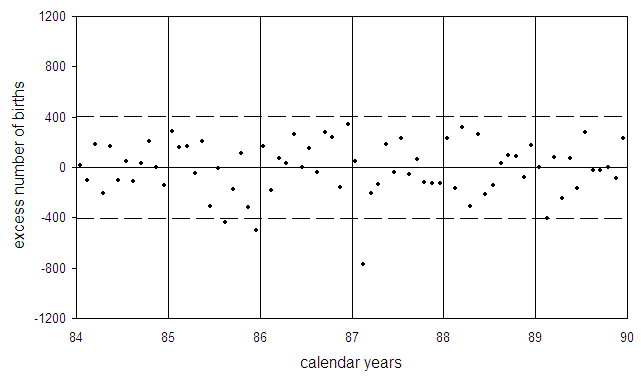Spontaneous
abortions
The
most sensitive phase in embryonic development is before the first cell division,
i.e., during the first hours after fertilisation. In this period an all or
nothing rule holds, i.e., the fertilised egg either survives without damage or
is aborted. A possible increase of spontaneous abortions will lead to a decrease
of live births 9 months after exposure.
As mentioned above, Bavaria was the German region with highest fallout. The figure below shows continuous measurements of the activity in air 1 meter above ground in the Munich based GSF Institute. Immediately after the Chernobyl accident the activity rose from 8 ÁR/h to about 110 ÁR/h.

Gamma dose rate in the air during May 1986
in Munich, Germany. In the first days of May it reached about 110 ÁR/h, more
than 10-times the normal level of 8 ÁR/h.
The number of live births plus stillbirths dropped significantly (p=0.0030) by
11.4% relative to the long-term trend in February 1987, nine months after May
1986. The decrease is more pronounced in southern Bavaria (-13,4%, p=0.0005)
than in northern Bavaria (-8.7%, p=0.0370) and is limited to a single month. In
March 1987, the number of births returned to the expected level. The following figure
shows the deviations of the monthly number of live births plus stillbirths in
southern Bavaria from the trend of the data, 1984-1989. The estimated number of
missing births in Bavaria in February 1987 is 1154. There might have been fewer
planned conceptions after the Chernobyl accident, but it does not seem plausible
that the fear of an adverse pregnancy outcome was limited to May 1986.

Deviations of the monthly number of live
births plus stillbirths from the long-term trend in southern Bavaria. The broken
lines indicate the 2σ-range.